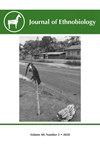《倾听蝙蝠:纳米比亚牧民的视角、故事和经历》
IF 1.3
3区 社会学
Q1 ANTHROPOLOGY
引用次数: 9
摘要
摘要虽然人们对非洲大部分地区的蝙蝠知之甚少,但在全球范围内,由于人类活动,许多蝙蝠的数量正在下降。因此,成功的蝙蝠保护工作取决于生态学研究和人类与蝙蝠关系的研究。为了解决这些关于非洲蝙蝠及其与人类相互作用的知识缺口,我们对纳米比亚西北部的牧民进行了半结构化访谈,以评估当地人对蝙蝠的经历、态度和文化故事。我们的研究与纳米布沙漠蝙蝠分布的生态学研究相结合,从而可以更广泛地了解该地区人类与蝙蝠相互作用的社会生态动态。虽然只有65%的受访者能够从照片中正确识别蝙蝠,但当提供“夜间飞行的动物”的额外描述时,100%的人将这些物种归类为蝙蝠。大多数(77%)的受访者表达了对蝙蝠的积极态度,超过三分之一(38%)的受访者提供了文化故事,详细报道了蝙蝠的神话和常见含义。在这些故事中,12%表示蝙蝠带来好运或好雨,84%具体说明蝙蝠代表坏运气或受伤、死亡、疾病或缺雨的预兆。虽然在我们的采访中从未提到栖息地丧失和丛林肉狩猎的主要威胁,但负面文化故事对个体行为的影响可能会对未来的蝙蝠保护举措构成挑战。这种定性方法与生态学研究相结合,可能对评估其他偏远地区人类与未充分研究的野生动物之间的跨文化关系有价值。本文章由计算机程序翻译,如有差异,请以英文原文为准。
Listening to Bats: Namibian Pastoralists' Perspectives, Stories, and Experiences
Abstract. While relatively little is known about bats across much of Africa, globally, many bat populations are in decline due to human activities. Successful bat conservation efforts, therefore, depend on both ecological studies and research on human-bat relationships. To address these knowledge gaps about African bats and their interactions with humans, we used semi-structured interviews of pastoralists in northwestern Namibia to assess local experiences with, attitudes toward, and cultural stories about bats. Our research was conducted in conjunction with an ecological study on Namib Desert bat distributions, thus allowing for a broader understanding of the social-ecological dynamics of human-bat interactions in this region. Though only 65% of interviews were able to correctly identify bats from photographs, 100% classified these species as bats when provided with an additional description of “animals that fly at night.” A majority (77%) of interviews expressed positive attitudes toward bats and over a third (38%) provided cultural stories, offering detailed reports of myths and common meanings assigned to bats. Of those stories, 12% indicated that bats brought good luck or good rains, and 84% specified that bats represented bad luck or omens of injuries, death, disease, or lack of rains. While the primary threats of habitat loss and bushmeat hunting were never mentioned in our interviews, the influence of negative cultural stories on individual behavior could pose challenges for future bat conservation initiatives. This qualitative approach combined with ecological research may be valuable for assessing cross-cultural relationships between humans and understudied wildlife in other remote areas.
求助全文
通过发布文献求助,成功后即可免费获取论文全文。
去求助
来源期刊

Journal of Ethnobiology
Social Sciences-Anthropology
CiteScore
4.80
自引率
3.40%
发文量
21
审稿时长
>12 weeks
期刊介绍:
JoE’s readership is as wide and diverse as ethnobiology itself, with readers spanning from both the natural and social sciences. Not surprisingly, a glance at the papers published in the Journal reveals the depth and breadth of topics, extending from studies in archaeology and the origins of agriculture, to folk classification systems, to food composition, plants, birds, mammals, fungi and everything in between.
Research areas published in JoE include but are not limited to neo- and paleo-ethnobiology, zooarchaeology, ethnobotany, ethnozoology, ethnopharmacology, ethnoecology, linguistic ethnobiology, human paleoecology, and many other related fields of study within anthropology and biology, such as taxonomy, conservation biology, ethnography, political ecology, and cognitive and cultural anthropology.
JoE does not limit itself to a single perspective, approach or discipline, but seeks to represent the full spectrum and wide diversity of the field of ethnobiology, including cognitive, symbolic, linguistic, ecological, and economic aspects of human interactions with our living world. Articles that significantly advance ethnobiological theory and/or methodology are particularly welcome, as well as studies bridging across disciplines and knowledge systems. JoE does not publish uncontextualized data such as species lists; appropriate submissions must elaborate on the ethnobiological context of findings.
 求助内容:
求助内容: 应助结果提醒方式:
应助结果提醒方式:


